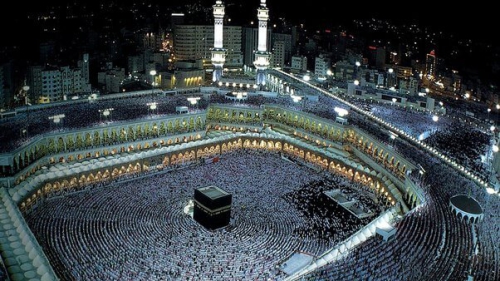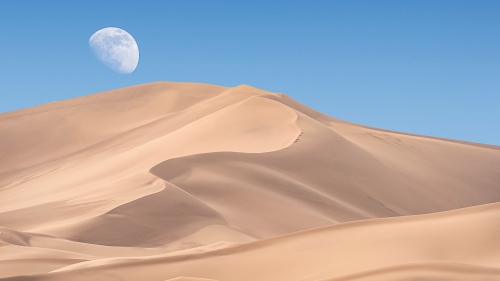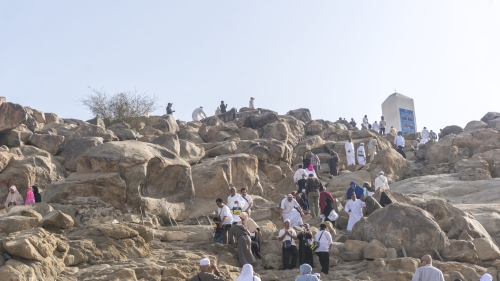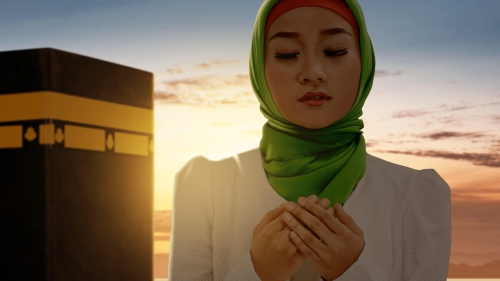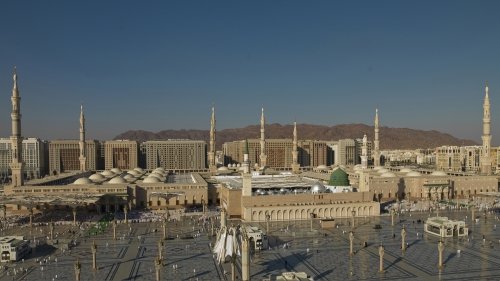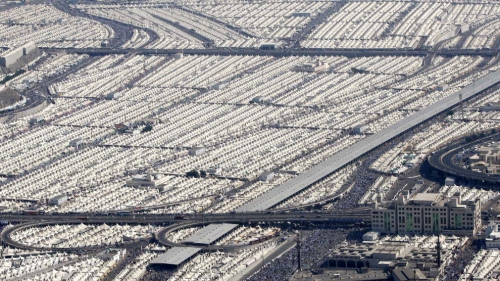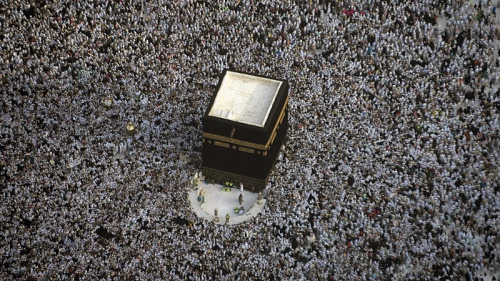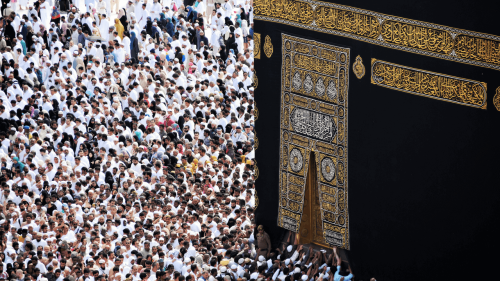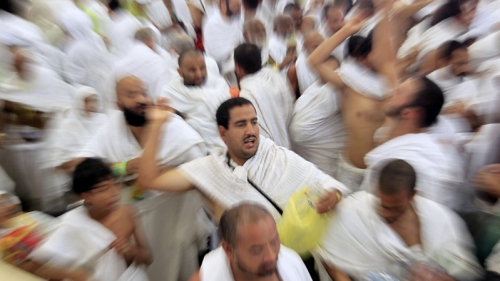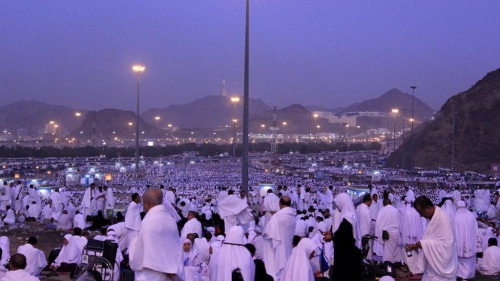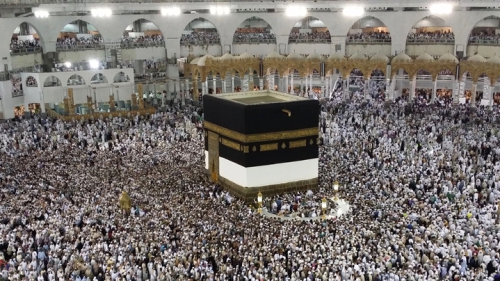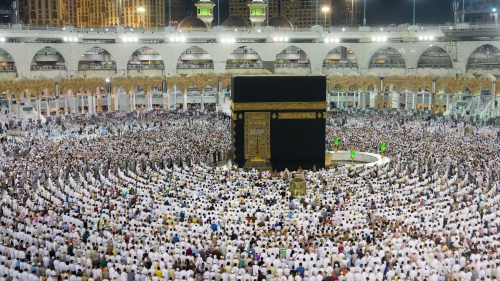The Spirituality of Hajj: Mina

From Muzdalifah, pilgrims move to Mina for the final stage of Hajj. While the distance between the boundaries of ‘Arafah and those of Muzdalifah is about 10 km, the distance between the boundaries of the latter and those of Mina is virtually non-existent. The two territories border each other. Thus, while the movement from ‘Arafah to Muzdalifah is tantamount to traveling, the movement from Muzdalifah to Mina is not really so. The latter is no more than a form of transfer or relocation to a neighbouring destination.
Due to the brevity of the Muzdalifah ritual, which takes place at night, there are – and there have always been - minimal accommodation facilities there. There is no need for pilgrims to protect themselves from the scorching heat of the sun, while they can sleep comfortably anywhere under the sky. In fact, to be natural and surrounded by nature is healthier and more impactful than being surrounded by and living in artificial settings.
This is unlike the case of ‘Arafah, whose ritual is also brief, but interim complex facilities are still required for sun protection and for other needs of people. ‘Arafah happens during the day, due to which there are more goings-on and people are busier than at Muzdalifah at night. As Allah underlines in the Qur’an to the effect that He has created the night as a covering and to rest, and the day for livelihood and as a means of subsistence. This way, the ‘Arafah and Muzdalifah rituals demonstrate their naturalness and how they are in sync with the in-built natural equilibrium of man.
That said, ‘Arafah and Muzdalifah are the largest makeshift human settlements in the world, which nevertheless genuinely exist and are fully operational in less than a day each year. Today, ‘Arafah features provisional accommodation facilities during its day of standing, while Muzdalifah does not during its own religious formalities. However, they both contain permanent mosques as an ultimate facility. The mosques are immense, with the aim of having capacity for as many people as possible. At ‘Arafah it is the Namirah Mosque, and at Muzdalifah the Mosque of al-Mash’ar al-Haram. The two Mosques are at once religious and historical monuments. Their presence serves as practical as emblematic ends.
The accommodation facilities of ‘Arafah in the form of standardized tents are briefly installed before Hajj and are removed immediately afterwards. As might be expected, preparing for, setting up and running such settlements – whose “inhabitants” could number up to three million people at the present time – in the middle of a desert and for less than a day only, poses a tremendous logistic challenge to the authorities. As the number of pilgrims keeps increasing, so do the trials and headaches for the organizers. Based on the feedback, there will never be a time when organizing and running the Hajj operations will be business as usual. The only thing predictable about Hajj is its unpredictability.
If pilgrims are duly aware of this, their appreciation of the Hajj phenomenon will be greater; as will be their fortitude and patience. Recalibrating expectations and, whenever needed, mind-sets, will likewise be a much easier proposition. It follows that imparting these realities to pilgrims, as part of their Hajj education, will do a great deal of expediency as well as justice for both pilgrims and organizers.
Mina, on the other hand, is somewhat a more permanent settlement. Which is plausible, because its religious rites go on for three or four days. Today, the valley of Mina is flooded with a sea of white tents, justifying the name of the place which is “Mina: the City of Tents”.
As a matter of fact, pilgrims stay at Mina twice. Firstly on the 8th of Dhul Hijjah, when they put on ihram and set out from Makkah, pilgrims come to Mina and spend the remainder of the day and the night there. There are no specific rites associated with this stay, except that pilgrims perform their regular prayers and do as much voluntary worship as they can. It is only after the sunrise of the 9th of Dhul Hijjah that pilgrims travel from Mina to ‘Arafah.
Mina with the first stop at it acts as an assembly point for pilgrims. From all corners of Makkah and beyond, they converge there. They refine and, if necessary, realign some of their thoughts for the vital days ahead. They embark on the last spiritual and psychological preparations with the intention of being equal to what those days have in store for them.
Whereas the city of Makkah contains a mixture of pilgrims and non-pilgrims, it is from Mina onwards that the stage is reserved for pilgrims exclusively. Hence, the first stop at Mina exemplifies orderliness, unity, and a sense of purpose as well as direction. The stop is a vestibule, as it were, that leads to a grid of Hajj’s biggest obligations.
In view of this, some of the meanings of the root word of Mina are “objective”, “wish” and “providence”. That means that pilgrims set their minds on performing the Hajj rites to the best of their abilities, and on procuring the promised rewards. They wish for and do the best, seeking to elicit thereby a divine intervention in their favour, which is in conformity with the religious code: “As for he who gives and fears Allah, and believes in the best (reward), We will facilitate for him the easy end (goodness and receiving rewards)” (al-Layl, 5-7).
The rituals of ‘Arafah and Muzdalifah being completed, pilgrims come back to Mina. They return to complete the cycle and to bring to an end that which they, right there, have gotten underway. There is only one day, spent at ‘Arafah, and one night, spent at Muzdalifah, which separate the two stays at Mina.
The 10th of Dhul Hijjah is action-packed and pilgrims are busiest. They do these rituals and in the following order 1As-Sayyid Sabiq, Fiqh us-Sunnah – Hajj and ‘Umrah, p. 101.: they throw the pebbles (symbolically stoning the devil), followed by offering the sacrifice, shaving one’s head (after which pilgrims remove ihram and become free from all restrictions associated with it, except engaging in sexual intercourse), and going to Makkah to perform tawaf around the Ka’bah (tawaf al-ifadah) and sa’y between Safa and Marwah. Pilgrims then return to Mina. The distance between Makkah (its Holy Mosque) and Mina is about 9 km.
There are three pillars (jamarat) that are stoned at Mina: the small (al-jamrah al-sughra), middle (al-jamrah al-wusta) and the big one (al-jamrah al-kubra or al-‘aqabah). Only the last one - i.e. al-jamrah al-kubra or al-‘aqabah (the big one) - is stoned on the 10th of Dhul Hijjah. During the subsequent three days: on the 11th, 12th and 13th of Dhul Hijjah – or the two days: on the 11th and 12th of Dhul Hijjah, as a concession stands - all the three jamarat pillars are stoned, starting with the small pillar, continuing with the middle and finishing with the big one. Seven pebbles are needed for each pillar and on each day. The small pillar is the first and the big one the last. The medium pillar, as the word implies, is situated in-between. The pillars are sited towards the end of Mina in the direction of the city of Makkah. They are separated by a distance of about 100-150 meters.
Like at ‘Arafah and Muzdalifah, at Mina too there is a mosque that is a main monument of the place. It is called the Khayf Mosque. Because the stay at Mina is relatively long, the mosque is used more frequently and for a wider variety of reasons. Its history is richer as well, extending beyond the epoch of the prophet-hood of Prophet Muhammad (pbuh). The Prophet (pbuh) is reported to have said that seventy prophets prayed in the Mina mosque, including Prophet Musa (Moses). This hadith is narrated by al-Tabarani and is not sound (sahih), but it is not weak either. Al-Albani classified it as hasan (good).
There are a few hadiths of the Prophet (pbuh) that mention the Khayf Mosque as a venue of the Prophet’s prayers at Mina and of his interactions with people and teaching them. In one of them, the Prophet (pbuh) is said to have prayed the Fajr (dawn) prayer. When he finished praying, he saw two men at the back of the people who had not prayed with him. He said: “Bring them here.” So they were brought to him, trembling. He said: “What kept you from praying with us?” They replied: “0 Messenger of Allah, we have already prayed in our lodgings.” He said: “Do not do that. If you have already prayed in your lodgings, then you come to a mosque in which there is a congregation, then pray with them, and it will be a voluntary prayer for you.” 2Al-Nasa’i, Sunan al-Nasa’i, Book 10, Hadith 82.
Accordingly, the Khayf Mosque is known as the Mosque of Prophets. Visiting it and praying in it, against the backdrop of the scene of Hajj and of days of yore, generate an additional aura of blessedness and historicity.
Yet another meaning of the root word of “mina” is “gushing forth”. This is related to the rite of the sacrifice at Mina, which is a confirmed Sunnah of the Prophet (pbuh). It means that Mina is a place of sacrifice. It is a sanctum associated with blood gushing forth annually from numerous sacrificial animals. The previously mentioned meaning of Mina – that is, “providence” or “destiny” – could also be fitted in here, in the manner of saying that those animals are sacrificed because God has preordained that particular outcome (destiny) for them. It is all the work of divine intervention and planning wherein even the minutest details are attended to.
The literal significations of Mina are encapsulated in the following. According to some reports, when Prophet Ibrahim was asked to sacrifice his son Isma’il, he was willing and ready to obey the command. However, humanely and as might be expected from any father, privately he was sad. Next, the angel Gabriel (Jibril) appeared to him at Mina and said: “Wish (tamanna)!” So, Ibrahim wished deeply that, as an absolution, Allah would substitute sacrificing Isma’il with the sacrifice of a ram. Given that Ibrahim’s wish was in accord with the disposition of divine providence – yet was a part of it - it was granted.
Thus, the linguistic meanings of the word “mina”: “wish”, “objective”, “providence” and “gushing forth” are captured in this story. However, the story is mentioned neither in the Qur’an nor in the authentic Sunnah of the Prophet (pbuh). It is a mere historical account most probably narrated by some members of the early Muslim generations as a result of the prevalence of other communities’ traditions, including those of the people of the Book. Just like a myriad of other accounts, this account too is to be neither accepted nor rejected. It is good for story-telling only and hence, for generating a feel-good factor in people, above all in pilgrims.
The same holds true for the professed historical and moral background of the foremost ritual at Mina: stoning the three jamarat, which figuratively epitomizes the stoning of the devil. One of the earliest and at the same time leading historians who supplied this background was al-Azraqi (d. 864). He said in his magnum opus “Akhbar Makkah (Reports on Makkah)” that, while the angel Jibril and Ibrahim were touring the holy sites of the city of Makkah and its Hajj, and while Jibril was teaching Ibrahim the rituals, they came to Mina. At the big jamrah (al-jamrah al-kubra) – to which they came first as they arrived from Makkah – they saw the devil (Satan or Iblis), whereupon Jibril instructed Ibrahim to call out “Allah is Greatest” and to pelt him with pebbles. The devil retreated to the middle jamrah, where Jibril asked Ibrahim to do the same thing. After that, the devil withdrew to the third jamrah (al-jamrah al-sughra) where again he was assailed with the cry of takbir (Allah is Greatest) and the pebbles. Then Jibril and Ibrahim proceeded to Muzdalifah and finally to ‘Arafah where the process of teaching Ibrahim the aspects of Hajj was completed. 3Al-Azraqi, Akhbar Makkah, (n.p.: Maktabah al-Asadi, 2004), p. 771.
Similarly, Abu Hamid al-Ghazzali advised pilgrims: “Make it your intention to imitate Ibrahim to whom the devil appeared at that place (at Mina) in order to cast doubt on his pilgrimage or tempt him to commit transgression, whereupon God Most High ordered him to throw pebbles at him to keep him away and to exterminate his hope.” 4Abu Hamid al-Ghazzali, The Book on the Secrets of Pilgrimage
It is permissible for pilgrims to slaughter their sacrificial animals anywhere at Mina and also anywhere within the precincts of the haram (sanctuary) of Makkah. Pilgrims may eat from the meat of their animals and may give some to the poor and needy of the haram. They may also take some meat outside the haram and may as well take back some with them to their homelands to eat or as a gift.
Regardless, these are externalities made flexible on purpose, so as to impose no hardships on people. There are always ways and means to accommodate necessities and circumvent obstacles. However, piety (taqwa) - whose locus is the human chest (heart) - is the objective, which by no means can be compromised.
Offering the sacrifice should be used for enhancing piety and improving devotion. The physical side of the act must not cast doubt on the spiritual one. The Qur’an draws attention to this verity: “Their (sacrificial animals) meat will not reach Allah, nor will their blood, but what reaches Him is piety from you. Thus have We subjected them to you that you may glorify Allah for that (to) which He has guided you; and give good tidings to the doers of good” (al-Hajj, 37).
At any rate, what goes on at Mina signifies two major existential thrusts: sacrifice and perennial confrontations with the devil (evil). A pilgrim learns that life is all about trials and sacrifices, and about square accounts. So insignificant is man in the grand scheme of things that operating alone and on one’s own is pernicious. Coalitions and reciprocity are the only option, should man wish to succeed in life and live through a happy ending. Not unexpectedly, alliances with the Creator – and with the members of His party on earth and in heaven - are most profitable.
It is a serious mistake to perceive life in a different light and live in an illusion. Only fools seek to live a perfect life in this world and to attain a total and lasting bliss. Utopias and nirvanas are unsuited for the permutations of the earthly existence. They cannot be transported from the realm of fantasies and dreams to the realm of actual realities. They are fated to remain just that. The pages of history are replete with failures. The very systems of thought and doctrines of the romantics and dreamers proved the necropolises of their endeavours. Positively, whether people like it or not, there is no life except the life of the Hereafter.
As Almighty God, the Creator of life and the Designer of its laws, said: “Do the people think that they will be left to say ‘we believe’ and they will not be tried? But We have certainly tried those before them, and Allah will surely make evident those who are truthful, and He will surely make evident the liars” (al-‘Ankabut, 2-3).
Also: “The life of this world is only the enjoyment of deception (a deceiving thing)” (Alu ‘Imran, 185). “Satan promises them and arouses desire in them. But Satan does not promise them except delusion” (al-Nisa’, 120).
At Mina pilgrims learn that sacrifices are continuous and diverse, both in terms of scale and impact. People must keep giving if they want to continue receiving. Self-interest and greed are anomalous and lead man to a collision course with the truth – and destiny. No matter how many wrongs are out there, they will not make a single right. Sacrifices empower and enrich; the lack of it puts off and impoverishes.
This subtle correlation keeps people on their toes and renders them resistant especially to the temptations of life’s frivolous things. People truly get in charge of that which is theirs, and whenever necessary they happily part with (sacrifice) possessions for the sake of fulfilling a more consequential purpose. In this situation, it is people who own and sacrifice, but in the cases of egocentrism and avarice it is people who are owned and eventually “sacrificed”. Such people do not have what it takes to win, and are habitually defeated.
Despite the fact that a pilgrim invests a lot in his Hajj, he returns from it richer than ever. He returns as a master, not servant, of his lower self. His body may be exhausted and weakened considerably, but his heart and soul are revitalized and breathed new life into. Although pilgrims sacrifice animals at Mina, in life nonetheless it can be anything they possess and hold dear, such as wealth, goods, time, comfort, well-being and opportunities.
Come rain or shine, pilgrims ought to be prepared for the inevitable, to take whatever is forthcoming into their stride, instead of being caught off-guard and unprepared. There is no place where Satan casts more of his lines than in troubled waters. The weaker a person is, the stronger his sworn enemy, Satan, becomes.
Irrespective of whether the accounts in which Ibrahim stoned the devil at Mina - originating thus the ritual of stoning the three jamarat - are sound or weak, the ritual is universally accepted as symbolizing attacks on the devil. It is not without reason that this is the last formality of Hajj. It indicates the culmination of a process, with a number of milestones, and its ultimate victory. The story of Hajj completed, the quintessence of the story of life starts unfolding.
Life is an everlasting confrontation between good and evil, and between man and Satan. It all started when Satan (Iblis) refused to prostrate before or bow down to Adam, and it will all end on the Day of Judgment when the “matter” will be concluded and decided, and when Satan will acknowledge that Allah promised people the promise of truth whereas he also promised, but betrayed, them; that he had no authority over people except that he invited them, and they responded to him. Satan will then add: “So do not blame me; but blame yourselves. I cannot be called to your aid, nor can you be called to my aid. Indeed, I deny your association of me (with Allah) before. Indeed, for the wrongdoers is a painful punishment” (Ibrahim, 22).
For a believer there is no respite from this conflict, which rages assuming infinite forms and patterns. A believer is here to prepare himself and, in the end, to defeat the advances of Satan and those of his associates from among the jinn as well as mankind. With Almighty God and the armies of heaven on his side, a believer is destined to win so long as he sticks to the criteria of devoutness and diligence. He may lose some battles, but what matters is that he wins the war. In any case, a believer stays honourable as much in victory as in defeat. He lives with honour, does battles with honour, celebrates victories and weathers defeats with honour, and dies as honourably as he lived.
This life drama is re-enacted in the theatre of Mina. Armed and enlightened as a result of the hitherto performed ceremonies in the Holy Mosque and at ‘Arafah and Muzdalifah, a pilgrim comes to Mina. He does so with determination and strategy, aching for some action. He knows that everything leads to that point and instant (all roads lead to Mina). As regards the practical implications of Hajj, it is not an exaggeration to say that Mina is the first moment of truth, yet the first measure or test of truth.
During the first day at Mina, of the three jamarat pillars a pilgrim goes only for the last and biggest one (al-jamrah al-kubra), bypassing the smaller first and second jamrah. It is the first day - having just arrived from ‘Arafah and Muzdalifah - and a pilgrim is primed for the biggest prize. He knows all too well that if the biggest idols are destroyed, dealing the rest a crushing blow is comparatively easy; if the principal devil incarnates are defeated, dealing with their minions is a foregone conclusion. A pilgrim makes a statement of intent thus.
A pilgrim goes for the root of all evil (symbolized by the biggest jamrah), acutely aware that Satan just yesterday on the day of ‘Arafah has been crushed and humiliated. He is still reeling, and though outraged, he is perhaps most vulnerable in the aftermath of the ‘Arafah – and Muzdalifah – spectacle. Hence, no sooner does a pilgrim come to Mina, than he is expected to strategize on the challenge and go for the kill. If properly planned and executed, onslaughts against Satan expose him and relegate his perceived strengths to the sheer debilities.
After the first day and the big battle at al-jamrah al-kubra, a pilgrim comes back for two or three more days (pilgrims are given concession to stay three or four days at Mina). Over the course of those subsequent days, in addition to targeting the biggest jamrah, a pilgrim targets the other two as well. The events of those days are ramifications of the first day’s ground-breaking event, the latter bringing to mind the similitude of going to the lion’s den, so to speak. Following the first and biggest battle, some additional scores will need to be settled later on. Like life, Mina is a protracted warfare, not one or a few intermittent skirmishes. It calls for discipline, training, morale and, of course, sacrifices.
Mina erupts into an out-and-out battlefield. What transpires at Mina connotes that battling Satan and his party is a huge task and should be systematic, focused, unyielding and relentless. Coming back to the jamarat pillars and pelting them (Satan) with seventy pebbles (staying four days) or forty nine pebbles (staying three days) – each pillar being hit with seven pebbles – is redolent of that. All the material idols, the idols of the soul, heart and mind (“cave”), alongside the spiritual, cerebral and behavioural faults and negatives of a person, are to be aimed at. The pre-Mina activities of Hajj enable a person to examine himself thoroughly, pinpoint lapses and identify the areas for improvement. Mina is a time and place to start taking action.
Al-jamrah al-kubra stands for a satanic godfather and the other two jamarat for its aides. However, the latter are still idols themselves, whose quantity should not be reduced to two only. Their number and the presence of their pillars are purely representational. Furthermore, each pebble, coupled with a throw as a sign of an effort, is a pilgrim’s declaration of war against all sorts of evil whose survival is attached to the presence of myriads of internal and external idols. Evil is a delicate network. It ought to be struck at its pivots.
Each pebble should be intended for eliminating an individual flaw in a person, which in turn should contribute to bringing down much bigger and much more substantial schemes, constitutions and paradigms (idols) within which those flaws are cast. Idols are not necessarily material and tangible. More often than not, they are immaterial and indiscernible, gradually consuming and destroying a person from within. A person may not even know what is going on.
Calling out with every pebble throw that “Allah is the Greatest” says it all. It shows that in a believer’s heart, worship-wise, there is no room whatsoever for anybody or anything other than Allah. Allah is the Originator of everything, the existence of everything depends solely on His grace, and to Him everything ultimately returns. Allah is the Cause of all causes and the End of all other ends. Therefore, with the exception of Allah, nothing is worthy of worship and serving. As the Qur’an proclaims: “Say: ‘Indeed, my prayer, my rites of sacrifice, my living and my dying are for Allah, Lord of the worlds’” (al-An’am, 162).
In the wake of either stoning the devil at al-jamrah al-kubra or offering the sacrifice, a pilgrim removes ihram and becomes free from all constraints connected with it, except engaging in sexual intercourse. This freedom is twofold.
Firstly, a pilgrim is free internally, having done away with his negative attributes – despite the fact that he might have just started the process and that the conflicts will go on ad infinitum – and having destroyed his “idols” and cast out his devils. A pilgrim is a liberated person ready to live accordingly and to forgo (sacrifice) whatever it takes and whatever may stand between him and the prospect of achieving a higher class of existential ideals.
In other words, a person is ready to dispose of anything that may jeopardize his newly found liberty and his new identity, both of which are priceless. Without question, this is the true meaning of freedom and what it means to fight for it, just as it is the true meaning of sacrifice and martyrdom. The activities of stoning the three jamarat in the course of the subsequent two or three days are proof that enlivening and preserving the newly found freedom - and self - is anything but an easy undertaking. A life-long dedication is required.
The second meaning of the above-mentioned freedom is that a pilgrim after removing ihram starts gradually returning to normalcy. Soon he becomes a civilian again. That he stones the three jamarat on the second, third and - if he chooses so - the fourth day, wearing civilian attire, illustrates that the affair of Mina, in essence, is the affair of everyday life. It is not a one-off and non-recurring exercise. Rather, battles with the self and the devil, with reference to the arenas of sacrifice, self-discipline and servitude, abide. They are quietened at one level, only to be stirred up at another.
A pilgrim discharges (frees) himself from one dimension of life’s exertions to another. In a way, he is on a journey of celestial proportions, pursuing freedom not for freedom’s sake but for being able to freely submit his total being to his Creator. Freedom without servitude is irresponsible and imprudent, whereas servitude without freedom is partial and unreal. Neither is ideal, nor productive.
A pilgrim finds freedom on Hajj and vows that he will enjoy it responsibly. He will subsequently neither slacken in his duties nor obstruct other people’s right to enjoy their own freedoms. Genuine freedom is obliged to beget goodness and to lead to more freedom. However, if the opposite happens, then what is called freedom is nothing else but a mirage. With the burden of his sins fallen, a pilgrim is like a born-again human being. He earned his freedom, and cherishing it is a sign of both contentment and gratitude.
Mina is a miniature copy of the fundamental nature of life. It is its embodiment. This can be further verified by the fact that, apart from being free from almost all ihram restrictions as a sign of gradual normalcy, pilgrims do not combine their prayers at Mina, unlike at ‘Arafah and Muzdalifah, even though they shorten them. This is so – and Allah knows best – because at Mina a pilgrim is more settled, and Mina itself is more of a settlement than ‘Arafah and Muzdalifah. At Mina, additionally, a pilgrim is closer to his usual self and his usual life procedures. He is more “at home”; he “settles and lives” at Mina, rather than just “passes through”.
Abu Hamid al-Ghazzali counselled that at Mina a pilgrim’s intention should be to submit to the command of God and to show servitude and bondage without any concern for benefits either to the mind or to the soul. A pilgrim must be sincere to himself and to God. Then his intention should be to imitate the example of Ibrahim and how he managed to keep the devil at bay.
“If the thought comes to you that Devil (really) presented himself to him (Abraham) and he saw him and therefore threw pebbles at him, but you (are something different), and Devil does not present himself to you, know that this thought is from the Devil and he is the one who put it in your mind to weaken your determination in throwing, and to make you imagine that it is a useless deed that resembles (mere) play, so that why should you bother yourself with it. Therefore, derive (this thought) away from yourself by diligence and by bracing yourself to throw (pebbles) at Satan in spite of Satan's (snares). Know that you are throwing only outwardly at al-‘Aqabah while in reality you are throwing at the face of Devil and breaking his back with it, for Devil will be overcome only by your compliance with the commandment of God Most High, and by your magnifying Him because of His commandment alone and not because of any benefit to the mind or the soul.” 5Abu Hamid al-Ghazzali, The Book on the Secrets of Pilgrimage
A pilgrim’s actions and Satan’s position and experiences at Mina could be one of the reasons why Satan is described as “rajim”, which technically means “cursed, condemned and abominable” and literally means “pelted with stones, stoned and expelled”. The word “rajm” means “missile, projectile, fireball and meteorite”. Satan is thus called primarily because he is attacked with meteors for eavesdropping on the secrets of heaven - as per the contents of several verses of the Qur’an (al-Saffat, 6-10; al-Mulk, 5) and a sound tradition of the Prophet (pbuh) 6Muslim, Sahih Muslim, Book 26, Hadith No. 5538. - and secondarily because he was cursed and expelled from Paradise, and because he is pelted with stones at Mina. At all times believers curse Satan and keep casting him out from their domains.
Mina teaches a pilgrim that in his wars with Satan and his armies he should take initiatives and go on the offensive, instead of drawing back and giving ground. Inertia and pacifism are as fatal. Being regularly on the defensive is a weakness, which Satan is ever ready to capitalize on.
All in all, there should be no exchange of mandates, nor ranks: believers are those who throw and banish, and Satan the one thrown at and banished; believers are those who generally control dealings and Satan the one who is controlled; believers are those who go from strength to strength and will eventually be victorious, while Satan slides back and will eventually fall flat. At Mina, Satan’s fate is sealed and his end prophesied.
Once a pilgrim throws pebbles he returns to his accommodation at Mina. He is free to do whatever he wants. As a matter of course, he is encouraged to engage himself in as many and as diverse worship activities as possible, both privately and collectively. The Khayf Mosque beckons the whole time.
However, the civilizational dimension of Mina should likewise be encouraged. Since pilgrims have much time on their hands, a variety of meetings, discussions and conventions should be organized and carried out with the agendas that are most pertinent to the Muslim cause, such as unity, education, alliances, defence and socio-economic wellbeing. A great many experts perform Hajj every year, in addition to those who could be invited, officially or otherwise, with the intention of boosting the efficiency of this particular dimension of Hajj.
Mina – and Hajj in general – should be transformed into a blueprint for reviving the civilizational consciousness of the Muslim ummah. It should be an annual Muslim congress where the most urgent themes are discussed, resulting in concrete policies and action programs. The congress’ status should be the “mother” of all Muslim congresses and conferences, with the former functioning as the nucleus and the latter as follow-ups.
Hajj should be a season of collective (ummatic) introspection and soul-searching, in Makkah and throughout Islamdom. In an ideal world, all Muslim eyes are supposed to be fixed on what goes on in, and comes out from, Makkah, and what the implications for individual and collective functioning are. Put differently, if Makkah is the spiritual qiblah (direction) of Muslims, it ought to be their cultural and civilization qiblah (reference point or gold standard) too.
To many people this may appear as though a farfetched possibility, however the crux of the matter is that Muslim cultural and civilizational aspirations need to be spiritualized (realigned with the spiritual qiblah), and that Muslim recurring spiritual functions need to be additionally culturalized and civilizationalized (the end products of those functions to be realigned with the pressing demands of the vicissitudes of time and space). Unless this unifying scheme is implemented Muslims will continue facing Makkah and its Holy Mosque in sheer spirit, but in body (productive ideas and works) they will be divided and dispersed, rummaging around for other “holy” sanctuaries and their qiblahs.
Admittedly, there are meetings and congresses organized annually nowadays during the Hajj season, but these leave much to be desired. By and large, things are staged, controlled and ostentatiously ceremonial. Extremely little is achieved thereby. A serious rethink is needed at once, if a change of fortune is truly wanted. The author himself attended a couple of such Hajj gatherings at Mina and was not impressed.
It was due to this that Jamaluddin al-Afghani (d. 1897) - an avant-garde Muslim scholar, ideologist, reformer and political activist – talked so much about the potentials of Makkah and its Hajj in the context of his thought on Islamic unity, brotherhood and cooperation (pan-Islamism). To Afghani, at least on the philosophical plane, Makkah was impervious to the banes of nationalism, sectarianism and fanaticism. It was also inaccessible to the physical expansionism and colonization of the West, which rendered it somewhat safer from the permutations of international politics than the rest of the Muslim world.
Afghani then put forward the embryonic idea of establishing an international network of Muslim scholars, activists and mere supporters from all walks of life, with Makkah functioning as a nerve centre and its annual Hajj season an opportunity for regular meetings. He furthermore suggested that mosques and schools across the Muslim world be transformed into centres of teaching, promulgating and facilitating Islamic unity, and that Makkah in its capacity as the personification of Islamic ideals function as the unifying factor and direction (qiblah). 7Jamaluddin al-Afghani, Inhitat al-Muslimin wa Sukunuhum wa Sabab Dhalik (pp. 92-97), al-Wahdah wa al-Siyadah (pp. 138-144), inside: “al-‘Urwah al-Wuthqa”, edited by Sayyid Hadi Khosroushahi, (Qom: Markaz al-Buhuth al-Islamiyyah, 2000).
Beyond doubt, conducting meetings and congresses at Mina in the name of Allah and for the sake of improving the wellbeing of Muslims across the world, is equivalent to any voluntary religious service, if not even better. In a broad sense, doing so is yet a part of dhikr (remembrance of God) and worship. It is integral to the edifice of Islam as a religion and a way of life. This can be substantiated by the following.
Before the advent of Islam, polytheistic Arabs used to hold meetings at Mina in celebration of the completion of Hajj. However, in those meetings they sang their own and their forefathers’ praises. They bragged about personal and ancestral achievements, turning the event into a sort of exhibitionism and even contest. It was all about them, and nothing about anybody else, either on earth or in heaven.
The Qur’an put an end to this inappropriate tradition and, in the overall spirit of Hajj, instructed Muslims to keep remembering God instead. Muslims should remember God as they remember their ancestors, or even more earnestly: “And when you have completed your rites, remember Allah like your (previous) remembrance of your fathers or with (much) greater remembrance” (al-Baqarah, 200). 8Ibn Kathir, Tafsir Ibn Kathir
Additionally, Muslims should not be like the pagan and materialistic Arabs who used to see but the material side of things, using the meritorious occasion of Hajj to implore God only for the things of this world: “And among the people is he who says: ‘Our Lord, give us in this world,’ and he will have in the Hereafter no share” (al-Baqarah, 200).
As an alternative, the Qur’an demands from Muslims to be pragmatic and to strike a balance between the exigencies of this physical world and those of the metaphysical Hereafter. The Qur’an further asks Muslims not to be myopic, but to expand their horizons: “But among them is he who says: ‘Our Lord, give us in this world (that which is) good and in the Hereafter (that which is) good and protect us from the punishment of the Fire” (al-Baqarah, 201).
Ibn Kathir narrated from Abdullah Ibn ‘Abbas who said: “During the time of Jahiliyyah, people used to stand during the (Hajj) season, and one of them would say: ‘My father used to feed (the poor), help others (end their disputes, with his money), pay the diyah (i.e., blood money),’ and so forth. The only dhikr (remembrance or tribute) that they had was that they would remember the deeds of their fathers. Allah then revealed to the Prophet (pbuh): ‘…remember Allah like your (previous) remembrance of your fathers or with (much) greater remembrance’ (al-Baqarah, 200)’.”
Another misconception that the Arabs had about Hajj is that doing business during Hajj was illegal. Abdullah Ibn ‘Abbas is reported to have said that Dhu al-Majaz and ‘Ukaz were trading posts during the time of Jahiliyyah. During that era, they did not like the idea of conducting business transactions for the period of the Hajj season. However, Allah eliminated the baseless misunderstanding by revealing: “There is no blame upon you for seeking bounty from your Lord (by trading during Hajj)” (al-Baqarah, 198). Before the revelation of this verse some Muslims used to shun business activities for the duration of the Hajj season, saying that these are the days of dhikr (remembrance of Allah). 9Ibid., https://www.alim.org/quran/tafsir/ibn-kathir/surah/2/198
The message of the Qur’an hereby is to the effect that “if a pious man observes the Law of Allah and then does some business to earn his livelihood, he really seeks the bounty of Allah. And there is nothing wrong in seeking the bounty of Allah along with seeking His pleasure.” 10Al-Maududi, Tafhim al-Qur’an That is to say, the whole life of a true believer is a form of worship and dhikr. He may not always remember Allah in the conventional sense of the term, but his constant awareness as to what is best to do in all circumstances and what is to be avoided – all because of his deep faith in Allah – is nothing short of what could be dubbed “utilitarian and silent dhikr”. Moreover, it is a form of living according to the implications of dhikr and a form of striving for the bounties of Allah.
Thus, organizing ummatic meetings and congresses at Mina for the sake of realizing the civilizational objectives (maqasid) cannot be disconnected from the notions of “dhikr” and “seeking bounty from Allah”. If earning a living on Hajj is permissible, arranging and running activities in furtherance of the interests of Islam and Muslims should then be deemed highly commendable. Yet it should be seen as a mode and degree of the holy struggle of jihad.
Muslims are bidden to shrink from liturgism and ceremonialism no matter what. They are to infuse the elements of Hajj with the purity of tawhid (God’s Oneness) and the distinction of the Islamic behavioural excellence. The conceptual or behavioural syndromes, which are inherited from the ancient Jahiliyyah or are imported from any of its modern counterparts, must be rejected. In no way is Hajj congruous with double standards, pretence and forgeries. The way the Qur’an and the Prophet (pbuh) dispensed with the prevalent misconceptions about Hajj should serve as a benchmark.
Muslims cannot be obsessed with one important thing, but neglect the other. One of the underlying qualities of Islam is its wholeness and integrity, which means that Islam is intended to be fully internalized and implemented as such in life. Compartmentalization is a religious crime, as is “spiritual favouritism”. For instance, Muslims cannot walk in the footsteps of pre-Islamic Arabs who used to do tawaf around the Ka’bah while naked, whistling and clapping their hands (al-Anfal, 35). Their hearts and minds were overflowing with wickedness and sin, yet they would strip themselves naked because they did not want to circumambulate the Ka’bah wearing the garments in which they had previously sinned. Thus they used to “honour” the Ka’bah and “purify” themselves. So shallow was their understanding – it was only their clothing-deep – that it could not penetrate their diseased hearts. Undoubtedly, a propensity for self-deceit is a severe demerit that firstly blinds a person, then annihilates him.
Ali Shariati elaborated on this socio-political and civilizational dimension of Mina: “There is a two (or three) day stay over in Mina to think about your ideology and what you have done. On the 'Id day and after the sacrifice, the ceremonies are over. You must stay two more days or even three more days, if you can, in Mina. You are not supposed to leave Mina these days - not even to return to Mecca! Why? Satan is defeated, sacrifice is offered, ihram is removed and 'Id is celebrated! Why should more than a million people remain in this valley for two or three more days! This time allows them to think about Hajj and understand what they have done. They can discuss their problems with people from other parts of the world who have the same faith, love, needs and ideology. Muslim thinkers and intellectuals who gather here and freedom-fighters who fight colonialism, oppression, poverty, ignorance and corruption in their homelands, get to know each other, discuss their problems, find solutions and ask for each other's help. Muslims from all over are supposed to study the dangers and conspiracies of the super-powers and their agents who have infiltrated Muslim nations. They should make resolutions to fight against brainwashing, propaganda, disunity, heresy, false religions…and many other diseases threatening the unity of Muslim nations. They should offer a common and worldwide struggle to introduce Islamic facts and support the cause of freedom for colonized nations and those Muslim minorities who are under the torture of fascist regimes as well as prejudiced political groups. Through a system of cooperation and understanding and an exchange of views and feelings, the Muslim communities would be strengthened in their struggle against their common enemy. A better understanding of true Islamic doctrine can be brought about by solving some of the theological differences that exist among Muslim religious groups.” 11Ali Shariati, Hajj: Reflections on Its Rituals, p. 111.
It is true that pilgrims can engage in commercial activities during Hajj and in particular at Mina – given that Hajj comes to its end there and people have plenty of time before their return to Makkah – is allowed, however that should not be turned into a mania. As innocent as it is to seek the bounties of Allah, seeking of Allah’s spiritual bounties is yet more gratifying. It is more enriching for a pilgrim. If Allah said that after the completion of the rituals people should remember Allah like their remembrance of their ancestors or with much greater remembrance, the same - by analogy - holds good for trade pursuits during Hajj. As if people are told that they can go after the worldly bounties, but their chasing after the honours of the Hereafter should be considerably greater.
When John Lewis Burckhardt (d. 1817) - a Swiss scholar, orientalist, explorer and geographer – secretly as non-Muslim performed Hajj in 1814/1815 he described the Mina market – which he even called a fair and a feast (festival) – in a rather spectacular manner. He wrote in his book that resulted from his Hajj, “Travels in Arabia”: “The street, which extends the whole length of Muna (Mina), was now converted into a market and fair: every inch of ground not built upon, was occupied by sheds or booths, made of mats; or by small tents, fitted up as shops. Provisions, and merchandise of every kind, had been brought here from Mekka; and, contrary to the custom in other Mohammedan countries, where all commerce is laid aside during the feast-days, all the merchants, shopkeepers, and brokers, were busily employed in traffic. The merchants who had arrived with the Syrian caravan, began their bargains for Indian goods, and exhibited samples of the articles which they had themselves brought, and which were lying in the warehouses at Mekka. A number of poor hadjys (pilgrims) were crying their small adventures, which they carried along the street on their heads; and as all business was confined to this single street, the mixture of nations, costumes, and merchandize, was still more striking than at Mekka…At night, the whole valley blazed; every house and tent was lighted up; before the tents of the (Egyptian) Pashas were fine illuminations; and the Bedouins made large bonfires upon the summits of the mountains. The noise of guns continued throughout the night; fire-works were exhibited; and several of the Mekkans let off rockets. The second day of the feast at Muna was passed in the same manner as the first.” 12John Lewis Burckhardt, Travels in Arabia, (London: Henry Colburn, 1829), pp. 280-282.
John Lewis Burckhardt also remarked on a festive gathering that involved the political elites mainly from Egypt, headed by nobody else but its powerful Ottoman governor and subsequently its de facto ruler, Muhammad Ali (d. 1849), and the socio-political aristocrats of Makkah. The gathering was conducted on the first day of the Mina stay and was celebratory in nature. It was a pompous occasion by all accounts and was used for consolidating reputations and furthering agendas. 13Ibid., pp. 281-282.
The occurrence was a specimen expressive of a thorny historical trend that continued well into present times. Instead of being subjected to and affected by Hajj, some people for different reasons try to affect and subject Hajj to themselves and their narrow schemes. Needless to say that certain political officials are the biggest culprits. To them, Hajj is an inconvenience, sometimes a threat. There is a whole world of difference between what Hajj stands for and what those people’s policies and programs call for.
With the dramatic rise in the number of pilgrims in modern times - who throng Mina, living there for several days, and who repeatedly and in droves stream towards the point of the jamarat to perform the stoning duty – Mina was increasingly becoming susceptible to mass accidents, many of which proved fatal. In the main, accidents were related to overcrowding and fire. For instance, between 1994 and 2015, several thousands of pilgrims either died or were seriously injured. In order not to transform Mina into a “place of human sacrifices” – together with the animal sacrifices – the authorities of the Kingdom of Saudi Arabia decided to act. The measures were decisive and extensive, and were gradually executed. The principles of “trial and error” and “learning from experiences and mistakes” were mainly followed.
The aim was to ensure the security, safety and comfort of pilgrims, so that they could enjoy their peace of mind and could concentrate on performing the religious obligations. The measures entailed the development of the jamarat multi-level bridge, wider jamarat pillars (now walls), wider column-free interior spaces, wider exterior spaces around the jamarat, extra ramps, footbridges, emergency exits and tunnels. All possible weak points, potential traps and bottlenecks were engineered out, with the purpose of ensuring easier – and safer – access and movement of people. It seems as if the design and plan of the new infrastructure adopted the principle of “form follows accessibility and movement”. So much so that the Mina layouts – especially its vast jamarat zone – resemble a river system that flows constantly and unhindered. Notwithstanding the volume of human traffic (flow), the watercourses have the capacity to contain it without overspill.
Furthermore, the measures involved the development of “flame retardant tents made of fiberglass tissues covered with Teflon, which are resistant to high heat and ignition, and which prevent the emission of toxic gases. The tents are linked to each other via paved, illuminated and signposted corridors, and each group of tents is surrounded by metal fences for security, with main gates and emergency exits. They provide communal areas, toilets and bathrooms, kitchens and electrical outlets, and are equipped with air-conditioning systems, are shaped in accordance with Islamic norms, and are made of flexible parts to ease storage and installation. The tents are either 8 square meters in size, 6 by 8 meters or 12 by 8 meters, and fire extinguishers and hoses are distributed across the corridors at approximately one every 100 meters. Water sprinklers that operate automatically upon sensing heat, are installed in each tent to extinguish fires, and the moment water is emitted from one, an alarm rings to alert security staff to the danger. Special water tanks have been installed in tunnels on top of the mountains near Mina, with a capacity of 200,000 cubic meters to be used to extinguish fires.” 14Mina, the City of Tents, https://www.arabnews.com/node/1896291/saudi-arabia
A series of articles adapted from the latest book by Dr. Spahic Omer, "The Spirituality of Hajj".
Footnotes
Topics: Hajj, Mina Values: Spirituality Channel: Hajj - Day 3, Hajj - Day 4, Hajj - Day 5
Views: 6049
Related Suggestions







